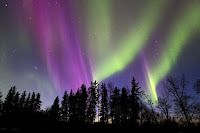2016-2017
We hope everyone had a very good suummer break, and that we are all ready for a wonderful year.During the 2016- 2017 school year, we will continue with our blog, expecting you all enjoy it.
AUTUMNAL EQUINOX
The Autumnal Equinox is observed annually when
the sun can be seen directly overhead along the equator, marking the end of
summer and beginning of fall in the Northern Hemisphere.
The autumn equinox is one of two days when all
points on Earth except the polar regions see the sun rise and set at due east
and due west. With few exceptions, all latitudes see almost exactly 12 hours of
daylight and 12 of dark.
Seasons are opposite on either side of the
Equator, so the equinox in September is also known as the Autumnal (fall)
equinox in the Northern Hemisphere. In the Southern Hemisphee, it's known as the Vernal (spring) equinox.
Equinox Local Time & Date
September Equinox in Madrid, Spain is on
Thursday 22nd september 2016, 16:21
Sun Crosses Celestial Equator
The September equinox occurs the moment the
Sun crosses the celestial equator – the imaginary line in the sky above Earth’s
Equator – from north to south.
On any other day of the year, either the
southern hemisphere or the Northern Hemisphere tilts a little towards the Sun.
But on the two equinoxes, the tilt of Earth's axis is perpendicular to the
Sun's rays, like the illustrations show.
Earth orbits the Sun at a slant, which is why
equinoxes and solstices happen
10 Facts About the
First Day of Autumn
1. It's the Second Equinox of the Year
The September equinox is on or around September 22, while the first equinox of the year, the March Equinox, takes place on or around March 21 every year. It marks the Southern Hemisphere's autumnal, or fall, equinox and the Northern Hemisphere's spring equinox.
 2. It's Time to Say Goodbye to Summer...
2. It's Time to Say Goodbye to Summer...
...in the Northern Hemisphere. Astronomically, the September equinox is the autumnal equinox, marking the end of summer and the beginning of fall (autumn). The fall season ends onDecember Solstice, when astronomical winter begins.
For meteorologists, on the other hand, fall in the Northern Hemisphere begins about three weeks before the September equinox on September 1 and ends on November 30.
3.Southern Hemisphere Welcomes Spring
The September equinox is also known as the vernal or spring equinox in the Southern Hemisphere and is considered by astronomers as the first day of spring there.
4.The Equinox is a Specific Moment...
Contrary to popular belief, equinoxes are no day-long events, even though many cultures choose to celebrate it as such. Instead, they occur at the exact moment the Sun crosses the celestial equator – the imaginary line in the sky above the Earth’s Equator. At this instant, the Earth's rotational axis is neither tilted away from nor towards the Sun.
5 ...And its Date Can Vary
The equinox dates vary because of the difference between how the Gregorian calendar defines a year (365 days) and the time it actually takes for the Earth to complete its orbit around the Sun (about 365 and 1/4 days). This means that each September equinox occurs about 6 hours later than the previous year's September Equinox. This eventually moves the date by a day.
 |
6, Equal Day and Night...
The term equinox comes from the Latin words aequus, meaning equal and nox, meaning night. This has led to the conventional wisdom that everybody on Earth experiences equal day and night – 12 hours of daylight and 12 hours of night time – on the day of the September equinox.
7. ...But Not Quite
In reality, most places on Earth enjoy more than 12 hours of daylight on this day. This is because of two reasons: the way sunrise and sunset are defined and atmospheric refraction of sunlight.
8.Time Between Successive Moonrises Becomes Shorter
The full Moon closest to the September equinox, which is also known as Harvest Moon in the Northern Hemisphere, is astronomically special. This is because the time between one moonrise to another around this period becomes shorter.
On average, the Moon rises about 50 minutes later every day in a lunar month – the time period between two full Moons or two new Moons. Around the Harvest Moon, the time difference between two successive moonrises decreases to about 30-40 minutes for a few days.
9. Prepare for Northern Lights
 As the September equinox rolls by, the chances that one can catch the aurora borealis display increases for those located at high Northern Hemisphere latitudes. According to NASA, the equinoxes are prime time for Northern Lights – geomagnetic activities are twice more likely to take place in the spring and fall time, than in the summer or winter.
As the September equinox rolls by, the chances that one can catch the aurora borealis display increases for those located at high Northern Hemisphere latitudes. According to NASA, the equinoxes are prime time for Northern Lights – geomagnetic activities are twice more likely to take place in the spring and fall time, than in the summer or winter.10. It is Celebrated Around the World
Many cultures around the world hold feasts and celebrate festivals and holidays to mark the September equinox.




